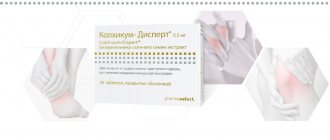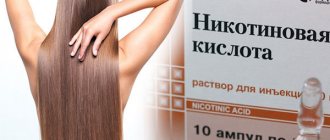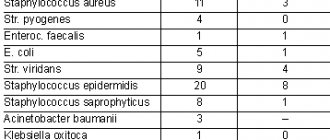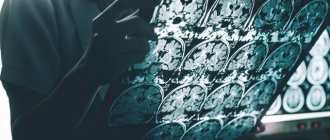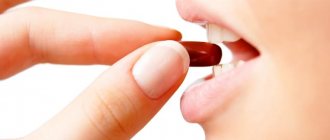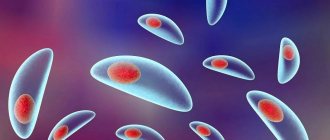Allergy
Cervical cancer
Uterine cancer
Rheumatism
Arthritis
11228 November 18
IMPORTANT!
The information in this section cannot be used for self-diagnosis and self-treatment.
In case of pain or other exacerbation of the disease, diagnostic tests should be prescribed only by the attending physician. To make a diagnosis and properly prescribe treatment, you should contact your doctor. We remind you that independent interpretation of the results is unacceptable; the information below is for reference only.
Protein S100: indications for use, rules for preparing for the test, interpretation of results and normal indicators.
Indications for prescribing the study
S100 protein is a substance (protein) that is present in many organs (skin, liver, kidneys, heart, etc.).
Its main feature is its ability to bind calcium and thereby influence many processes occurring in the body. This protein is necessary for the normal functioning of organ and tissue cells, but the highest content of S100 is found in brain cells. The level of S100 protein in the blood allows us to assess the degree of brain damage due to stroke, traumatic brain injury and other conditions leading to neurological diseases. The concentration of S100 protein increases in cancer. The study of S100 protein levels is of great importance for the assessment and monitoring of skin cancer treatment.
Basic information
The term “S 100 protein” combines a whole group of low molecular weight calcium-binding proteins found only in vertebrates. There are about 25 of them in total. In the body, these proteins perform many different functions and are involved in a wide variety of intra- and extracellular processes, regulate the cell cycle and apoptosis, and are involved in the development of cancer.
S 100 proteins are tissue- and cell-specific, i.e. secreted only by certain types of cells. In our case, an increase in the production of the S 100 (B) protein subtype is provoked by the activity of melanoma cells. But besides this, the analysis can provide clinically important information about a number of other diseases: Alzheimer's disease, stroke or other neurological pathologies. In case of traumatic damage to brain tissue, subarachnoid hemorrhage, inflammatory processes, this study will also be very useful.
Preparation for the procedure
- It is preferable to wait 4 hours after your last meal.
- It is recommended to donate blood in the morning, between 8 and 11 o’clock, and avoid food overload the day before.
- Avoid drinking alcohol on the eve of the test.
- Do not smoke for at least 1 hour before the test.
- Avoid physical and emotional stress on the eve of the study.
- When studying the concentration of S100 protein over time, it is recommended to conduct repeated studies in the same laboratory.
Function of S100 protein
Various forms of S100 proteins represent the most universal of the known macromolecules, which are involved in the regulation of almost all major membrane, cytoplasmic and nuclear metabolic processes associated with providing mechanisms for the perception and integration of information entering the nervous system, take part in the response of early response genes, and in the implementation of genetic programs of apoptosis and anti-apoptotic protection.
Representatives of S100 proteins demonstrate pronounced tissue-specific and cell-specific expression. They are involved in various processes - contraction, motility, cell growth and differentiation, cell cycle progression, transcription, cellular membrane organization and cytoskeletal dynamics, protection from oxidative cell damage, phosphorylation, secretion.
S100Β has been shown to exhibit neurotrophic activity at physiological concentrations and neurotoxic activity at high concentrations.
The participation of proteins of the S100 group in the regulation of processes of directed growth of neuron processes, in the completion of neuroontogenesis both morphologically and functionally, in the formation of the main forms of innate behavior, in the mechanisms of memory and learning has been experimentally proven. Numerous studies have proven the connection of the S100 protein with the development of anxiety disorders.
Reference values
Normally, the concentration of S100 protein in the blood is less than 0.105 μg/L.
Interpretation of the result is carried out for the purpose of a comprehensive assessment of the condition of various brain diseases, prognosis and control of treatment in oncology, as well as in inflammatory processes, for example, rheumatoid arthritis. There are several different types of S100 protein. To indicate the type of protein S100, an alphanumeric designation is added to the name, for example, S100A1. Different types of S100 protein are characteristic of different organs. Determining the specific type of S100 protein is important in cardiology, oncology, and in brain injuries and pathologies.
In cardiology, elevated concentrations of species such as S100A1, S100A2 and S100A4 indicate acute damage to heart cells (myocardial infarction) and infective endocarditis (damage to the heart, especially its valves, by various bacteria). The S100 level is used in addition to the “classical” biomarkers: creatine kinase (CK), creatine kinase-MB (CK-MB) and troponin-I.
The study of the S100 protein group is valuable in patients with inflammatory diseases and allergies. In acute inflammation, levels of S100A8, S100A9 and/or S100A12 tend to increase. These proteins are considered nonspecific markers of activation of phagocytes (cells that destroy bacteria and viruses), so determining the values of S100A8/A9 and S100A12 with other markers of a particular disease increases diagnostic accuracy. The table shows the relationship of the S100 protein with some diseases.
| Indicator (protein S100) | Diseases in which S100 plays the role of an additional biomarker of inflammation and allergies |
| S100V | Vitiligo (skin pigmentation disorder) |
| S100A4 | Relationship between inflammation and tumor progression Allergy Seasonal allergic rhinitis (allergic rhinitis) |
| S100A7 | Psoriasis (inflammatory skin disease) |
| S100A8 | Rheumatoid arthritis (chronic inflammation of the joints) Crohn's disease (chronic bowel disease) Inflammation of the gastrointestinal tract Inflammatory lung diseases |
| S100A12 | Kawasaki disease (damage to small vessels by the immune system) Vascular inflammation and atherosclerosis |
The S100 quantitative determination test presented by the Independent Laboratory INVITRO is aimed at identifying such protein types as S100A1B and S100BB.
The life of a modern person is inevitably associated with stressful situations that give rise to a whole range of emotional experiences. Stress negatively affects all areas of life, hindering personal development, impairing the perception of information (learning), making adequate decisions and provoking negative human behavior - smoking, alcohol abuse, etc. According to the World Health Organization, millions of people in the world suffer from related with stress, neurotic and somatoform disorders, mood disorders, in particular, various types of depression. It is predicted [1] that by 2030 clinical depression will become the most common illness in the world. Stress-related disorders are also factors that aggravate the course of somatic and neurological diseases (stroke, dementia, multiple sclerosis, Parkinson’s disease and epilepsy) [2].
The most commonly used drugs in medical practice to correct the above disorders are psychotropic drugs of the tranquilizer group (benzodiazepine derivatives) and selective serotonin reuptake inhibitors. However, they have a number of side effects that limit their use in outpatient practice, especially in those individuals whose profession requires rapid mental and motor reactions. In addition, with uncontrolled long-term use of such drugs, especially in high doses, there is a high risk of developing mental and physical dependence [3].
Medicinal products whose activity is aimed at the biochemical correction of disorders of integrative brain activity are considered as promising drugs. One of the ways to have such an effect on the body is to modulate the activity of endogenous function regulators, for example S100 proteins.
S100 proteins are a multigene family of low molecular weight homo- and heterodimeric Ca2+-binding proteins. Among more than 20 representatives of this family in the central nervous system (CNS), the dominant position is occupied by the S100 B dimer [4, 5]. This protein is synthesized primarily by astrocytes and microglial cells and then transported to neurons, where it can be found in a soluble form or a form associated with intracellular membranes, centromeres, microtubules, and type III intermediate filaments. This protein is involved in many intra- and extracellular processes. In particular, it has been shown that S100B stimulates the differentiation and proliferation of neurons, stimulates the growth of dendrites, affects the integrity of the cytoskeleton, inhibiting the assembly of microtubules by isolating tubulin and stimulating sensitivity to Ca2+ of the forming microtubules, and also, by inhibiting the assembly of intermediate filaments, increases the survival of neurons, is involved in transduction of the Ca2+ signal (coupling the increasing level of intracellular Ca2+ and protein phosphorylation), regulates the energy metabolism of the cell [4, 5]. In addition, S100B influences the impulse activity of neurons due to the modulation of K+ currents: when the protein acts on a neuron, the resting potential hyperpolarizes, the spontaneous generation of action potentials is suppressed, the neuron’s response to stimulation changes from tonic to phasic, the duration of the action potential decreases, and the trace increases hyperpolarization and the cell input resistance decreases [6]. The described effects contribute to the stabilization of the impulse activity of the neuron and a more differentiated response to stimulation.
For the first time, S100 B was detected in the cerebrospinal fluid (CSF) of a patient diagnosed with multiple sclerosis at the acute stage [7]. Then it was detected in increased quantities in biological fluids (peripheral blood, CSF, amniotic fluid, saliva) of patients with other brain injuries (acute encephalomyelitis, amyotrophic lateral sclerosis, intracranial tumors, etc.). Since then, the S100B protein has been used as a diagnostic marker for various diseases, for example, hypoxic brain damage (in particular, ischemia after stroke) and Alzheimer’s disease [8]. The dynamics of S100B concentration in severe CNS lesions in newborns in the first week of life makes it possible to predict the outcome of the disease and adjust therapy [9].
Plasma S100B levels have been shown to be elevated in depression [10]. This fact supports the hypothesis that neurodegenerative processes are involved in the pathogenesis of this disease. Enough information has also been accumulated on the participation of S100 proteins in the pathogenesis of anxiety. Thus, transgenic mice with increased expression of the S100 protein demonstrated increased anxiety in the open field (OP) and Y-maze tests [11], while S100 knockout mice, on the contrary, had decreased anxiety [12]. Immobilization stress and electric shock caused an increase in the content of S100 protein in the blood serum of experimental animals [13], and the smell of a predator in the CSF [14]. It is also of interest that an increase in the amount of S100B occurs in the blood and urine of healthy people as a result of prolonged mental and physical activity with stress load [15]. Antibodies to the S100 protein change the activity of neurons in the hippocampus and hypothalamus, causing their inhibition, and as a result, relieve motivational stress aimed at implementing the alcoholic behavior stereotype [16].
From the above it follows that S100 proteins are a promising pharmacological target in the search for substances for the treatment of mental and neurological disorders, drug addiction, correction of neurodegenerative processes, and regulation of the body’s functioning under stress.
Currently, there are no small molecular ligands that could be used to regulate the activity of S100 proteins. However, influencing protein functions can be achieved using antibodies. This confirms the existence on the modern pharmaceutical market of such drugs as tenoten, tenoten for children, divaza, brizantin, colofort and proproten-100, the active component of which is the release-active form of antibodies to the S100 protein (RA anti-S100). The peculiarity of these drugs is that, thanks to a certain production technology, dilutions of anti-S100 acquire the so-called “release activity”, due to which the drugs are able to have a modifying effect on the S100 protein (their endogenous ligand).
The basis for the appearance of such drugs was preliminary ex
vivo
studies led by Academician. RAS M.B. Stark in the “Research Institute of Molecular Biology and Biophysics”, which showed that anti-S100 RA, without directly affecting the induction of long-term post-tetanic potentiation (LPTP) in rat hippocampal slices, prevents the blocking effect of large doses of antibodies to S100 on LPTP [17 ].
Subsequently, the spectrum of pharmacological activity of RA anti-S100 was established in numerous experimental and clinical studies. The main properties of RA anti-S100, identified in preclinical studies (at the cellular, tissue and organ levels), which are the most promising in therapeutic terms, are presented in this review (see figure).
Experimentally studied effects of RA anti-S100
Preclinical studies of RA anti-S100
Preclinical studies of drugs containing RA anti-S100 were carried out in accordance with national and international recommendations in leading research centers in Russia, the CIS countries and abroad: “Research Institute of Pharmacology and Regenerative Medicine named after E.D. Goldberg" (Tomsk, Russia), "Institute of Experimental Medicine" (St. Petersburg, Russia), "Research Institute of Pharmacology named after V.V. Zakusov" (Moscow, Russia), "Scientific (Novosibirsk, Russia), "Research Institute of Normal Physiology named after P.K. Anokhin" (Moscow, Russia), Moscow State University. M.V. Lomonosov (Moscow, Russia), Ukrainian Research Institute of Clinical and Experimental Neurology and Psychiatry of the Ministry of Health of Ukraine (Kharkov, Ukraine), (Paris, France), (Paris, France), (Gossely, Belgium).
Anxiolytic activity of RA anti-S100
The studies were carried out using basic methods for assessing anxiolytic effects: the conflict situation technique in the Vogel version, the elevated plus maze (EPM) and the AP test, which are widely used in Russia and abroad [18]. Experiments were carried out on outbred white male rats (230-250 g). Activity of R.A. anti-S100 was evaluated in comparison with diazepam or placebo (distilled water, DV).
According to Vogel, the conflict situation was created by a collision of drinking and defensive motivations, when every attempt by the animal to take water was punished by electrical pain stimulation. A measure of the severity of the anxiolytic effect of the drug was considered to be an increase in the number of punishable takes of water from drinking bowls [18]. To study the activity of RA anti-S100 depending on the individual response to stress, additional groups of animals were also used: before the administration of drugs, rats were typed into high- and low-active in the forced swimming test in a vessel with freely rotating wheels according to Nomura, in which stress is simulated and astheno-stimulation is assessed. depressed state of animals.
RA anti-S100 was not inferior to diazepam in terms of the severity of the anxiolytic effect [19]. Moreover, in low-active animals, characterized by a tendency to anxious-depressive behavior [20], RA anti-S100 was superior to diazepam in effectiveness, and in highly active animals it was not inferior to diazepam. The data obtained indicate that RA anti-S100, in addition to anxiolytic activity, has an antiasthenic, activating effect, which distinguishes it from diazepam, which combines an anxiolytic effect with a sedative.
The PCL method is based on the fear of open space and falling from a height: animals are placed on the central platform of the maze installation and the latent period of the first exit into the open arms of the maze, the number of complete and incomplete exits and the duration of stay in them, as well as the number of hanging from the open arms are recorded [ 18].
It was found that RA anti-S100 and diazepam had a similar anxiolytic effect: the drugs increased the number of exits into open arms (by 1.9 and 2.3 times, respectively), the time spent in open arms (by 5.4 and 7 times), as well as the number of overhangs (5 and 9 times) [20].
The OP test is widely used to study the behavioral characteristics of rats: animals are placed in the center of the OP and visually assessed horizontal and vertical activity, exits to the center of the OP, as well as the number of acts of defecation and urination (emotionality).
RA anti-S100 and diazepam showed pronounced anti-anxiety activity in the OP, this was expressed primarily in the fact that the rats began to move to the center of the field, which was not observed in the control group. Moreover, unlike diazepam, which reduces the horizontal activity of animals by 1.5 times, anti-S100 RA did not change this indicator and, therefore, did not have a sedative effect.
Anti-stress activity of RA anti-S100
Efficacy against somatovegetative manifestations of stress
In everyday life, a healthy person often experiences stress in anticipation of pain or other unpleasant effects. In particular, before a surgical operation, while waiting for an outpatient appointment, before exams, important meetings, unmotivated anxiety, a feeling of inner restlessness, and fear appear. The indicated emotional and affective disorders, in combination with the existing defect in the neurovegetative regulation of the visceral systems, provoke the development of an imbalance of the autonomic nervous system, in which all organs and systems of the body (cardiovascular, respiratory, digestive, genitourinary, endocrine, etc.) are involved in the pathological process. Negatively colored human memories against the background of altered autonomic-visceral regulation, in turn, can become a trigger factor in the development of autonomic dystonia. For example, while waiting for a dental appointment, the patient remembers the pain of the previous treatment, and the appearance of a doctor in a white coat in the waiting room, sounds and smells from the treatment room are additional irritants and increase the stress of anticipating pain. Emerging negative emotions trigger a cascade of somatovegetative manifestations of stress before the direct impact of a painful stimulus, especially against the background of a constitutional predisposition [21].
An experimental study of the effect of RA anti-S100 under the stress of anticipating pain was carried out on outbred white male rats (220-280 g) by modeling a conditioned emotional reflex to unavoidable electrical pain stimulation with further registration as the spontaneous behavior of animals in a stressful situation (repeated placement in the experimental chamber) , as well as an emotional reaction when stress is increased by an additional stimulus (bringing an unfamiliar object to the animal’s head) [22]. Activity of R.A. anti-S100 was evaluated in comparison with diazepam, administering the drugs one day after the development of the conditioned reflex.
Rats in the control group, when subsequently placed in a dangerous chamber, reacted by freezing (45%) or actively trying to get out of the chamber (35%). Only 20% of the rats showed calm behavior. At the same time, somatovegetative manifestations of stress were observed in animals (especially those with a passive reaction): breathing became more frequent, urination and defecation increased, and a squeak appeared. RA anti-S100 and diazepam caused a decrease in the number of rats with a passive and active reaction to stress and significantly (3 times) increased the number of animals with a calm orientation-exploratory reaction. Somatovegetative manifestations of stress also normalized in both groups.
The emotional reaction of anxiety and concern associated with the expectation of painful stimulation in a dangerous chamber was significantly enhanced by the use of an additional provocation - bringing an unfamiliar object to the animal's head. This was manifested in an increase in the number of rats with active (up to 40%) or passive (up to 55%) behavior and a decrease in the number of animals with calm behavior (up to 5%). Respiratory distress, squeaking, defecation and urination also increased. RA anti-S100 and diazepam reduced the severity of pain anticipation stress. At the same time, the drug RA anti-S100 equally (by 20%) reduced the number of animals with spontaneous active and passive reactions, while diazepam more pronouncedly reduced the number of animals with active attempts to get out of the chamber (by 30%) than the number of animals with freezing (by only 10%). The same trend persisted with additional negative provocation, which may be due to the presence of a sedative effect in diazepam and the absence of such an effect in RA anti-S100, as well as with a more pronounced effectiveness of RA anti-S100 than in diazepam in animals that were more sensitive to stress.
c-Fos protein expression
It is known that under conditions of emotional stress the expression of the early gene c-fos
in the paraventricular nuclei of the hypothalamus is one of the primary links that reflect the activation of the central nervous system and characterize the resistance of animals to stress load [23].
The effectiveness of stress-protective compounds can be assessed by their ability to suppress stress-induced expression of the early c-fos
in a given structure.
The study was conducted on male Wistar rats (250-280 g), divided into active and passive in the O.P. test. It was previously shown that active animals in population terms are prognostically resistant to stress, while passive animals are predisposed to it [20].
Rats were injected with RA anti-S100, imipramine (a drug that suppresses the expression of the early gene c-fos
) or DV and were then subjected to one-hour immobilization with simultaneous electrocutaneous stimulation [24].
The
c- Fos protein in the neurons of the parvocellular part of the paraventricular nuclei of the hypothalamus of the animal brain was detected by an indirect histochemical method 90 minutes after the procedures—at the peak of
c- Fos expression
.
In response to stress, c- F os
increased statistically significantly in both active and passive animals (20-25 times), and in the latter this increase was more pronounced. RA anti-S100 and imipramine showed equally pronounced anti-stress activity in relation to passive animals: a decrease in the number of Fos-positive cells was observed by 1.2 and 1.5 times, respectively.
Ulceration under immobilization stress
Another important indicator of the development of the body’s stress response and the severity of destructive processes is the formation of ulcers on the gastric mucosa. It is known that immobilization stress is accompanied by pronounced ulceration of the gastric mucosa, as well as morpho-functional changes in organs involved in the development of stress: hypertrophy of the adrenal glands and involution of the thymus [25] .
A study of the anti-stress activity of RA anti-S100 was carried out on male Wistar rats (250-280 g), divided into active and passive in the O.P. test. Animals were injected with RA anti-S100 or DV [24]. After 24 hours, half of the rats from each group were fixed by their paws on a special platform for 1 hour, and then the number of ulcers formed in the stomach was counted.
In the group of passive animals, 72.7% more ulcers were observed than in the group of active rats, which confirms their higher sensitivity to stress. Preparation R.A. anti-S100 reduced the number of animals with ulcers and the total number of ulcers in the group of passive (but not active) rats, which complements previous findings of higher effectiveness of the drug in passive, highly stress-sensitive animals [26].
Thus, we can conclude that RA anti-S100 has a protective effect against stress-induced ulceration on the gastric mucosa.
Antidepressant activity of RA anti-S100
The antidepressant activity of RA anti-S100 was studied in the test of behavioral despair (helplessness) according to Porsolt and forced swimming in a vessel with wheels according to Nomura on outbred white male rats (250-300 g) [27]. Activity of R.A. anti-S100 was evaluated in comparison with amitriptyline.
In the Porsolt behavioral despair (helplessness) test, animals were placed in a vessel with water. The rats began to exhibit vigorous motor activity aimed at finding a way out of the aversive (unpleasant) situation, but then hovered in the water, remaining completely motionless or making minor movements necessary to maintain their muzzle above the water. The duration of immobilization is an indicator of a depressive state. Preparation R.A. anti-S100 exhibited an antidepressant effect comparable to amitriptyline: immobilization time decreased by 1.6 and 1.8 times, respectively [27].
In the Nomura forced swim test, animals were placed in a container with wheels filled with water. The number of wheel revolutions was recorded for 10 minutes. Preparation R.A. anti-S100 and amitriptyline statistically significantly reduced the manifestations of depression (both drugs increased the number of wheel revolutions by 1.8 times) [27].
Anti-aggressive activity of RA anti-S100
This type of anti-S100 RA activity was studied under conditions of unmotivated and motivated aggression in outbred mature white male rats (200–250 g) in comparison with diazepam, administering the drugs once or for 4 days before testing [28].
In the test of unmotivated aggression, based on studying the threshold of an aggressive reaction of a pair of animals on the electrode floor with increasing stimulating current, an aggressive reaction was considered to be the behavior of rats in which the animals stood on their hind legs with their muzzles facing each other (boxer stance) and tried to strike with their forelimbs and bite each other.
RA anti-S100 and diazepam, with single and (to an even greater extent) course administration, increased the threshold for an aggressive reaction; the effectiveness of the RA anti-S100 drug was not inferior to diazepam. Thus, after a single administration of RA anti-S100, the estimated indicator increased by 23.1%, and after 4 days - by 34.9% compared to the control, while diazepam increased the aggressive reaction thresholds by 26.3 and 31. 3%, respectively [28].
The method of motivated aggression is based on studying the intensity of the aggressive reaction caused in a pair of rats by the desire to avoid electrical pain punishment on a small platform. The criterion for the effectiveness of substances with an anti-aggressive effect in this test is the duration of being together in close but safe conditions.
The rats developed a conditioned reflex to avoid electrical pain stimulation of the paws on a safe bench installed in the center of a chamber with an electrode floor, and then they were placed in the chamber in pairs and their behavior was observed for 2 minutes. The control animals began to fight for a safe bench, the size of which allowed two animals to sit on it. The criterion for the effectiveness of substances with anti-aggressive effects in this test was the duration of joint avoidance of pain.
RA anti-S100 and diazepam had a pronounced anti-aggressive effect, increasing the duration of joint avoidance: with a single administration by 3.4 and 3.1 times, respectively, and with a course administration by 3.8 and 3.3 times [28].
Nootropic (anti-amnestic, neuroprotective) activity of RA anti-S100
The ability of RA anti-S100 to improve cognitive functions was confirmed in experimental studies of the drug’s effectiveness in models of such widespread pathologies as hemorrhagic and ischemic stroke, multiple sclerosis, Alzheimer’s disease, attention deficit hyperactivity disorder. In addition, the presence of anti-S100 anti-amnestic activity in RA was shown in a model of amnesia in conditions of disruption of the process of developing a conditioned reflex or during its formation using suboptimal reinforcement.
Hemorrhagic stroke
- is a life-threatening vascular disaster. The clinical reflection of the hemorrhage that has occurred in the brain tissue is the development of psychoneurological deficit: from mild to severe severity with cognitive, emotional-volitional, speech, motor and sensory defects. Treatment of hemorrhagic stroke at the first stage includes a set of resuscitation measures aimed primarily at maintaining the functioning of the vital centers of the brain. In the future, the main goal of the therapy is to restore lost functions of the central nervous system. For this purpose, drugs with neuroprotective, antioxidant, and nootropic effects are used [29].
Hemorrhagic stroke was modeled in outbred male rats (200–250 g) [30]. Activity of R.A. anti-S100 was evaluated in comparison with nimodipine, administering the drugs once before surgery to simulate the pathology and then for 14 days. We studied the survival of animals, the effect of substances on the neurological deficit caused by hemorrhagic stroke on the McGrow scale, impairment of cognitive functions in the test of conditioned passive avoidance reflex (CARP), emotional status in the PCL and OP tests, and impaired coordination of movements in the rotating rod test [31].
In the control group (without drug administration), by the 14th day there was 50% mortality, the development of neurological deficit in 60% of surviving rats, as well as a decrease in muscle tone in 50% of cases and amnesia (2-fold decrease in the latent time of CPAR). Preparation R.A. anti-S100 prevented the death of animals, led to a decrease in the proportion of rats with neurological deficits and reduced muscle tone, and also had anti-amnestic and anxiolytic effects [30]. Nimodipine did not affect the survival of animals after hemorrhagic stroke and exhibited an effect similar to RA anti-S100 on neurological deficit and muscle tone with significantly less pronounced anti-amnestic and anxiolytic effects [30].
Ischemic strokes
account for 70–85% of all stroke cases, and the ratio of the incidence of ischemic and hemorrhagic types of stroke is 4:1 [32].
The anti-ischemic effect of RA anti-S100 was studied on a model of local photochemical damage to the prefrontal cortex of animals, modified by I.V. Viktorova [33]. This model allows one to obtain impairments in memory and learning ability without disorders of motor coordination and muscle tone and is widely used to assess the effect of anti-ischemic substances.
The experiment was carried out on outbred white male rats (180-200 g). Activity of R.A. anti-S100 was evaluated in comparison with piracetam, Cavinton or 0.9% NaCl, administering the drugs for 9 days after modeling photothrombosis. Then the effect of the drugs on the pathomorphological changes in the cerebral cortex, the behavioral reactions of animals in the OP and the reproduction of the CPAR developed before the operation were assessed.
The RA anti-S100 drug completely eliminated amnesia caused by ischemic stroke and was superior in effectiveness to piracetam and Cavinton. At the same time, a positive neuroprotective effect of RA anti-S100 on brain tissue was shown: the drug restored disorders both in the necrosis zone and in the perifocal zone [33].
Glucose and oxygen deprivation
Modern in vitro
Models of cerebral ischemia include models of creating hypoxia of brain cells (oxygen deprivation models), models of oxygen deprivation and simultaneous creation of other conditions (oxygen and glucose deprivation, oxygen/glucose deprivation and creation of metabolic ischemic conditions), as well as models of glutamate excitotoxicity and oxidative stress [34]. At the same time, to search for substances with neuroprotective properties, continuous cultures of neuroblastoma are often used as a research object - cells that have all the important properties typical of neurons: they are electrically and chemically excitable, have ion channels and receptors, and have an enzymatic apparatus for synthesis mediators, as well as the system necessary for their inactivation, form processes similar to nerve fibers [35].
The experiment was carried out on mouse neuroblastoma tumor cells (C 1300), which were placed in a medium with RA anti-S100 or with DV without glucose, pre-aerated with an oxygen-free gas mixture (95% N2 and 5% CO2) for 20 hours [36]. Control cultures were kept in a CO2 incubator in a standard medium containing glucose. The drugs were tested according to three schemes: 1) they were added to the culture medium simultaneously with the cells; 2) 20 hours before hypoxic exposure, then transferring the cells to a medium without the drug; 3) 20 hours before hypoxic exposure and throughout its entire duration. The neuroprotective activity of RA anti-S100 was assessed by the number of surviving cells.
In all testing options, the effectiveness of the RA anti-S100 drug exceeded the value in the control (15%), amounting to 27, 32 and 35%, respectively [36].
Multiple sclerosis
This pathology belongs to a group of neurological diseases characterized by the development of severe progressive organic lesions in the central nervous system and peripheral nervous system, the pathophysiological basis of which is the destruction of the myelin sheath.
The most adequate model of multiple sclerosis is experimental allergic encephalomyelitis (EAE), caused by the injection of spinal cord homogenate [37]. In this model, as in multiple sclerosis, an immune response is carried out to all components of myelin: inflammation is induced, followed by demyelination, degeneration of axons, and then the nerve cells themselves. A pathological chain of events appears with the development of paresis, paralysis and other symptoms of the disease.
EAE was modeled in female Wistar rats (200–220 g) by injecting homologous spinal cord homogenate with complete Freund’s adjuvant into the base of the tail [38]. Activity of R.A. anti-S100 was evaluated in comparison with glatiramer acetate (Copaxone) and DV, administered for 30 days after induction of pathology.
RA anti-S100 and Copaxone equally (2 times) increased the survival of animals. Both drugs reduced disease severity, as reflected by a decrease in the total score for the entire study and the maximum score at the peak of the study. Copaxone predominantly affected rats with a mild form of EAE, reducing their number by 4 times compared to the control, while RA anti-S100 affected animals with a severe form of EAE, reducing their number by 7 times compared to the control [38].
Alzheimer's disease
is a slowly progressive degenerative disease of the central nervous system. The leading cause of the development of Alzheimer's disease is currently considered to be the accumulation of pathological beta-amyloid protein in brain cells, leading to the loss of neurons and synaptic connections in the cerebral cortex and some subcortical areas, resulting in a wide range of neuropsychiatric manifestations. Cognitive and emotional-personal disorders come to the fore, becoming more severe as the disease progresses. Therefore, nootropic, neuroprotective, antioxidant and anxiolytic drugs are often used to correct mnestic and emotional disorders in patients with Alzheimer’s disease [39].
The disease was modeled on outbred white male rats (230-250 g) by administering the M-anticholinergic blocker scopolamine - they reproduced the cholinergic deficiency that occurs during aging and is one of the main pathogenetic mechanisms of the development of Alzheimer's disease. Then, for 10 days, the animals were injected with RA anti-S100 or DV, after which cognitive functions (learning dynamics in the URAI formation test), neurological status according to the McGrow scale, muscle tone (pull-up on a wire), coordination of movements (rotating rod test) and anxiogenesis (ACL) [19].
A course of administration of RA anti-S100 led to the restoration of the ability to learn URAI; decreased the proportion of animals with reduced muscle tone (1.5-2 times) and ptosis. The drug had an anxiolytic effect in the PCL (increased the time spent in open arms by 5 times) and increased motor activity [40].
Attention Deficit Hyperactivity Disorder
(ADHD) is a neurological-behavioral disorder that begins in childhood [41]. The formation of ADHD is based on neurobiological factors: genetic mechanisms and early organic damage to the central nervous system. It is they who determine violations of higher mental functions (memory, attention, speech, praxis and behavior), corresponding to the clinical picture of ADHD. The use of nootropic drugs for ADHD is pathogenetically justified. Nootropics have a stimulating effect on insufficiently formed higher mental functions, and also have a positive effect on metabolic processes in the central nervous system and promote the maturation of the inhibitory and regulatory systems of the brain.
The experiments were carried out on outbred white rats (age 30-35 days, corresponding to 4.8-10.5 years of human life), among which, using the OP test, animals with increased motor activity were selected, and then, using test stimuli and indicators Brady and Nauta scales, rats with impulsive inappropriate behavior were selected [42]. Activity of R.A. anti-S100 was evaluated in comparison with phenibut and DV, administered for 7 days before testing.
The RA anti-S100 drug had a pronounced ability to improve CPAR learning and reduce the hyperactivity of animals, which was expressed in an increase in the latent time of entering the dark chamber by 3.4 times compared to the control and a 3-fold decrease in the number of movements between the illuminated platform and the dark chamber. Anti-S100 was superior to phenibut in its effect on RA learning [42].
Amnesia in conditions of disruption of the process of developing a conditioned reflex or during its formation using suboptimal reinforcement
The mnemotropic activity of RA anti-S100 was also studied in conditions of impaired CPAR formation and in the incomplete process of its production [42]. For this purpose, white outbred rats (age 30-35 days) were injected with RA anti-S100, piracetam or D.V. for 10 days. Then they gave an injection of scopolamine and trained CPAR, or only trained CPAR using suboptimal reinforcement - in a mode in which insufficient development of the reflex was observed. One day after CPAR training, the integrity of mnestic processes was assessed.
In both models, a positive mnemotropic effect of the tested drugs was noted. Thus, in the first case, RA anti-S100 and piracetam increased the latent period of entry into the chamber where electrical pain stimulation had previously been applied by 8.6 and 8.9 times, respectively; in the second, the indicators exceeded the value in the control by 4 and 2 times.
Preventive and therapeutic activity of RA anti-S100 in conditions of the formation of pathological dependence and abstinence
The emergence of a pathological craving for alcohol is associated with disruption of the activity of certain structures of the brain stem and limbic system, where the so-called “reinforcement system” is located. Chronic alcohol intoxication is associated with pathological changes in the activity of calcium, potassium and sodium channels. This explains the severe disturbances in brain functioning, which manifest themselves especially sharply in the first days after stopping the abuse of alcoholic beverages. Chronic alcoholism also leads to an imbalance of neurotransmitter systems (GABA-, glutamate-, dopamine-, serotonergic, opioid
What is the anti-RBD test and what does it show?
It is currently known that the envelope of each SARS-CoV-2 virus consists of 4 structural and non-structural (protease, replicase) proteins:
- S protein (spike), or spike protein;
- N protein, or nucleocapsid protein:
- M protein, or membrane protein and
- E coat protein.
It is the S protein (spike) that gives the virus the recognizable appearance of a “corona virus.”
One of the properties of the S protein, more precisely its receptor-binding domain (RBD), is the ability to combine the envelope (membrane) of the virus with a human cell, thereby ensuring penetration into the cell and further infection of the body. In response to infection, the body begins to react by producing antibodies of various classes. It is their detection that makes it possible to establish the fact of infection even in asymptomatic patients. IgG begins to be detected on average at the 3rd week of the disease, moving through the vascular bed of patients for a long time. Laboratory testing can determine IgG to various viral proteins. The presence of IgG antibodies to the nucleocapsid protein is an indicator of past infection. Detection of IgG to the receptor binding domain (RDB) allows one to judge the presence of protective immunity, which could have formed after the disease or after vaccination. Antibodies to the S protein binding domain receptor have neutralizing properties and prevent the virus from binding to human cells, thereby providing an important role in determining the individual protective immune response to SARS-CoV-2.
Features of preparation and analysis
Preparing for the procedure excludes eating in the last twelve hours, but you must drink water.
To determine the brain-specific protein, venous blood is taken from the elbow (3-5 ml), in the morning on an empty stomach using the puncture method. The sample is sent in a tube for electrochemiluminescent immunoassay. The patient is required to properly prepare:
- Eat your last meal 4-6 hours before, ideally 8-12 hours before.
- Before the analysis, drink only water (purified, without gas).
- Avoid training for 4 days.
- 30 minutes before sample collection, do not be nervous and do not smoke.
The selected biomaterial is subjected to centrifugation in the conditions of the laboratory that collected the sample. This step is necessary to remove clotting factors. The S100 tumor marker is calculated by the level of luminescence during the reaction of enzyme-labeled antibodies with a chemiluminescent substrate. The analysis is carried out for several hours, and the answer is usually given within a day, not including the day of taking the biomaterial, in units of measurement - μg/l (micrograms per liter).
Treatment of abnormalities
A blood test for protein S-100 is used to monitor the course and control the success of treatment of melanoma, for the early detection of metastases and relapses. In addition, it is performed as part of a comprehensive examination if brain damage is suspected. The results make it possible to predict neurological consequences and determine treatment tactics. With the test results, you must contact the doctor who referred you for the test. Most often this is an oncologist, neurologist or cardiologist. To avoid a physiological increase in S-100 protein levels, you should avoid intense physical activity several days before blood collection.

